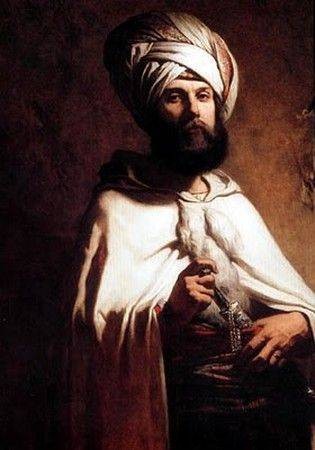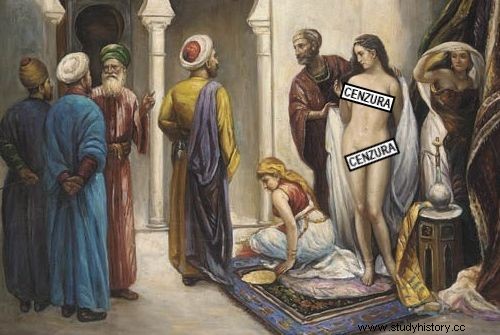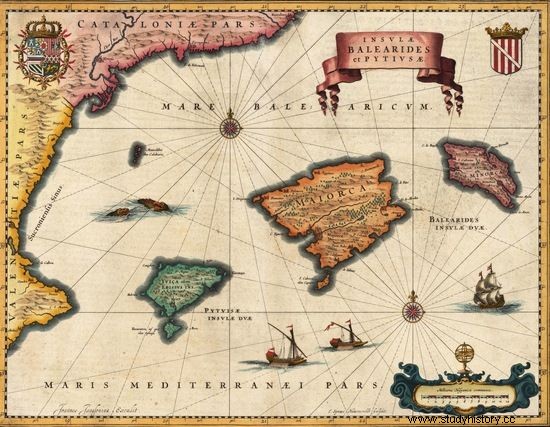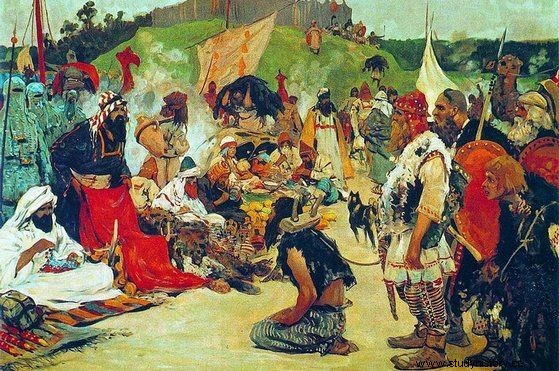A Polish slave is taken to Spain, where he regains his freedom and under the name Mudżāhid takes over Ibiza. Such a story could have happened in the times of Bolesław the Brave.
Where did the Poles on the Iberian Peninsula come from? They were among the Slavic slaves who in the Middle Ages were an extremely valuable "commodity" in Muslim Spain. Jewish merchants were particularly active in this business. It is enough to remember Ibrahim ibn Jakub, whose account about the country of Mieszko I is quoted in practically all school textbooks. This one dealt mainly with human trafficking.

Abd al-Rahman Sanchuelo, he was the first Lord of the Mujahida.
In turn, our first chronicler, Anonymous called Gall, writes about Judith, the mother of Bolesław the Wrymouth, that many Christians redeemed from captivity from Jews with their own money .
Slaves from Poland went either to Khorezm (a land in today's Uzbekistan, Turkmenistan and Iran), and from there to Asian markets, or via Prague, Regensburg, Mainz, Verdun and Lyon to the Iberian Peninsula. The stay in Verdun must have been especially painful.
In Spain, the greatest demand was for young slaves, young men who could be drafted into the army, and eunuchs, while Verdun was regarded as a place of "castration" production.
Cheeky and ambitious Slav
We do not know how old the Slavic slave, later known as Mudżāhid, was when he entered the Caliphate of Cordoba, which at that time covered a large part of the Iberian Peninsula. He was maybe a child, maybe a teenager. He was very lucky. First, he was not castrated on the way. Second, he found a very high-ranking master - Abd al-Rahman Sanchuelo, the powerful minister of Caliph Hisham II.
It can be assumed that Mujāhid served in the Slavic Guard for some time. As the medievalist and orientalist Tadeusz Lewicki wrote, the position of the Slavic guardsmen could be compared to the position of the Roman praetorians during the fall of imperial power .

Arabs made real coconuts on the Slavic slave trade. However, sometimes fate smiled on slaves as well, as exemplified by the story of Mujahida.
In time, Mujāhid gained freedom and became the governor of the city of Denia, located on the Costa Blanca. Probably the end of the career of the Slavic ex-slave, but in 1009 the Caliphate of Cordoba was engulfed in civil war. One of her first victims was Sanchuelo, the former lord of Mujāhida. Caliph Hisham II lost power to one of his relatives, Muhammad II.
Caliph appointed by a Pole?
The Mujahid backed the new caliph but later decided to play on his own. In June 1010, he communicated with the Catalans and began creating his own state. He took Tortosa, but two Slavic officers ruling Valencia obeyed him (although for a short time).
As if that were not enough, he found some distant relative of Hisham II and proclaimed him caliph. He named himself Hajiba (in Muslim Spain it was roughly the equivalent of the title of vizier, known in the Middle East).
In 1015 he took the Balearic Islands (including Ibiza) and Sardinia. He also chased away his "caliph", who turned out to be of little use, and also tried to get out of the role of a puppet. A year later, Pope Benedict VII organized the Genoa and Pisa fleets and recaptured Sardinia.
This failure did not significantly affect the situation of Mujahid. Fortunately he ruled in his country for over thirty years. He died in June 1045 and was succeeded by his son Ali.

Mudjahid captured the Balearic Islands in 1015 and did not cede power for a long 30 years. First from the left is Ibiza.
Pole or not Pole?
In the title of the article I mentioned the supposed Polish origin of the Mudżāhida. So why do I consistently present him as a Slav in the text? Muslim sources did not distinguish between individual Slavic tribes or nations; they used the collective term Saqualiba for them .
In this mass of Slavs (around 960, in Cordoba alone, there were 13,000 of them!), Which ended up in Muslim Spain, had to include newcomers from Poland. They also had to constitute a considerable percentage, counting how large and populous country was Bolesław the Brave's Poland. So did the ruler of Ibiza also come from the Vistula? A tempting vision that cannot be excluded.

Around 960, as many as 13,000 Slavs lived in Cordoba alone. The majority of them were slaves. The illustration shows a painting by Sergei Vasilyevich Ivanov depicting the Slavic slave trade.
Even if a Mujahid was not a Pole, there is a possibility that one of our countrymen became the ruler on the Iberian Peninsula. At the beginning of the 11th century, after the collapse of the Cordoba caliphate, many such states, called typhoons, were created. Some were ruled by Slavs with non-Slavic names:in Valencia Mubārak, in Lerida Muzaffar, in Almeria Chajrān.
It turns out that a thousand years ago Poles found their way to the West not only as a cheap labor force. At least some (even castrated along the way) were going for property, power and fame.
Sources:
Basic:
- Bruce Travis, The politics of violence and trade:Denia and Pisa in the eleventh century , "Journal of Medieval History" 32, 2006, pp. 127-142.
- Fletcher Richard A., The Quest for El Cid , New York 1991, pp. 29-30.
- Collins Roger, Caliphs and Kings. Spain:796-1031 , Chichester, UK - Malden, MA 2012.
- The history of the Mohammedan dynasties in Spain; extracted from the Nafhu-t-tíb min ghosni-l-Andalusi-r-rattíb wa táríkh Lisánu-d-Dín Ibni-l-Khattíb, by Ahmed ibn Mohammed al-Makkarí, a native of Telemsán , crowd. Pascual de Gayangos, vol. 1, London 1840.
- Lewicki Tadeusz, Spain. Slavs in Spain , [in:] Dictionary of Slavic Antiquities, vol. 2, 1964, p. 217.
- Saybold C. F. , Denia , [in:] E. J. Brill's First Encyclopaedia of Islam 1913-1938 , New York 1987, vol. 2, pp. 938-939 (reprint from The Encyclopedia of Islam. A Dictionary of the Geography, Ethnography and Biography of the Muhammadan Peoples , New York 1931-1938).
Complementary:
- Lewicki Tadeusz, Slavic slave trade in Arab countries , [in:] Dictionary of Slavic Antiquities, vol. 2, 1964, pp. 190-192.
- Same, Slavic settlement and Slavic slaves in Muslim countries according to medieval Arab writers , "Przegląd Historyczny" 43, 1952, issue 3-4, pp. 473-491.
